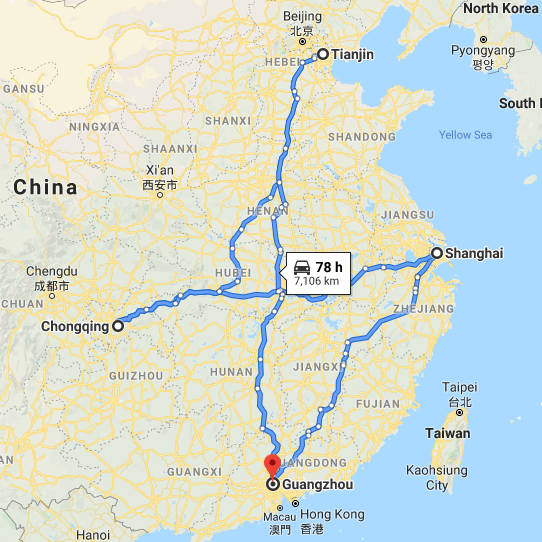Do you travel to Asia to visit suppliers? Do you plan to do so in the future?
In order to maximize the results of your trip, it is important that you plan your trip carefully.
In our blogs, we focus mainly on quality control and sourcing-related topics, but since many people in our audience find themselves traveling frequently to this continent, we decided it would be a good idea to share some of our travel tips.
In this article, we provide a list of five tips that we think are helpful for visiting countries like China, Vietnam, Cambodia, and others. But what do you think? Do you agree with these points? Do you have anything to add? Let us know in the comments.
#1 – Consider the Logistics of Your Trip Carefully
If you are visiting multiple cities during your trip, it is important to minimize backtracking. You don’t want to waste time traveling in such a way that you are spending more hours than you need to in the air or on a train.
For example, let’s say you are going to visit four cities in China, flying into and out of Guangzhou and decided to visit them in this order:
- Guangzhou
- Shanghai
- Chongqing
- Tianjin
- Guangzhou
Following this itinerary, your travel path would look something like this Google Map.

You probably aren’t driving, but if you were, you would end up with a total driving time of 78 hours and covering 7,106 kilometers.
A better choice would be to take a route like the following, keeping in mind the locations of these cities and their proximity to each other:
- Guangzhou
- Shanghai
- Tianjin
- Chongqing
- Guangzhou

This shorter route cuts the trip down to 63 hours and 5,690 kilometers in Google Maps. Now, of course, if you fly or go by high-speed rail, the trip will be much shorter than this. But it should be clear you will see time and cost savings by taking a more efficient route.
#2 – Take Advantage of the APEC Card
If you are going to travel around Asia frequently, it makes sense to consider the APEC card. The Asia Pacific Economic Cooperation Business Travel Card “facilitates short-term business travel within the APEC region by streamlining the entry process into APEC economies.”
This card allows you to “fast-track entry and exit through special APEC lanes at participating airports,” so that you can minimize immigration wait times.
In addition to the APEC card, there are other programs you can take advantage of, such as the Hong Kong e-channel pass for frequent border crossers who enter China through Hong Kong.
#3 – Choose the Right Ride
 There are always a number of options available for traveling around Asia. When traveling in China, you may want to consider high-speed rail as an alternative to flying from city to city. Flights in China are often delayed and trains are more likely to be on time.
There are always a number of options available for traveling around Asia. When traveling in China, you may want to consider high-speed rail as an alternative to flying from city to city. Flights in China are often delayed and trains are more likely to be on time.
But if you don’t speak the language or have someone to help you book travel and navigate the station, this could be a bit more difficult.
Once you arrive in a city and to your hotel, you may be tempted to use the car service they offer to get around town. But a taxi, Uber, or other car services like DiDi in China or PassApp in Cambodia are often more economical.
In general, it’s best to skip hotel cars and use these apps to catch a ride instead.
#4 – Choose a Hotel Chain and Stick With It
While loyalty to an airline isn’t usually beneficial, loyalty to a hotel chain can be. By maximizing the number of nights you stay with a particular chain, you can unlock lounge access, which can be a very nice benefit in Asia.
Lounges tend to offer more than they would in the U.S., often providing full meals as opposed to appetizers. In addition, you can earn additional nights, which is also a nice perk.
#5 – Choose the Right Credit Card
In years past, airline credit cards seemed to offer a good deal. By having loyalty to a particular airline, you could earn miles that would count toward future travel bookings. But loyalty to airlines has become less and less fruitful as airline miles have become watered down over time.
It is generally best to shop for a flight based on factors like price and travel time as this will generally save you more money in the long run than points for a particular airline. When thinking about credit cards, consider ones that offer cash back or provide other kinds of travel benefits like access to airport lounges or special status with hotels and don’t tie you down to a specific airline.
What are Your Thoughts About Travel in Asia?
Aside from the suggestions above, do you have any travel hacks you use to save time and money or avoid headaches?
Let us know in the comments if you do.




Great advice! For travel in China, I always found it helpful to use the app Ctrip, now Trip.com, which offers an English version and which is fully integrated into China’s transit system. You can easily find trains (both high-speed and non) as well as flights and long-distance buses. Much easier than trying to navigate the Chinese language apps which are similar.